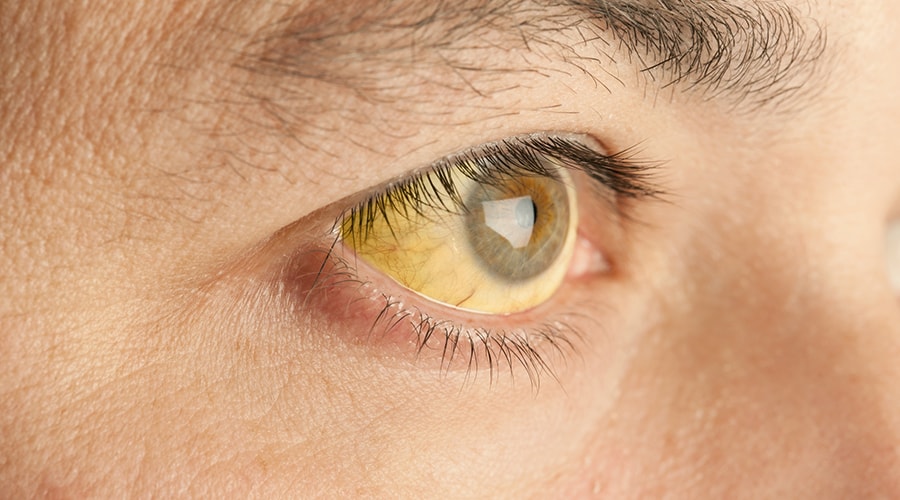
With this new column, Elite Healthcare will compile an index of various infectious diseases, with occasional highlights of emerging conditions.
Jaundice
General definition and information:
Although not a contagious condition in and of itself, jaundice can be caused by a number of communicable diseases. A condition that occurs when too much bilirubin, a yellow chemical in hemoglobin and byproduct of the breakdown of red blood cells, builds up in the body, jaundice is commonly known to occur in otherwise healthy babies (physiologic jaundice) because newborns will contain an excess of bilirubin because of greater production and faster breakdown of red blood cells in the first few days of life. While the adult liver normally filters bilirubin from the bloodstream and releases it into the intestinal tract, a newborn’s liver often cannot remove bilirubin quickly enough because the organ is immature, thus causing the excess of bilirubin. Marked by the yellowing of the skin, eyes, and mucous membranes, jaundice, also known as icterus, causes your skin and the whites of your eyes to turn yellow. When it occurs in otherwise healthy infants, jaundice typically goes away without treatment in a few days. But the condition can happen at any age and may be a sign of a more serious problem. The condition is diagnosed through physical examination and tests that may include liver function tests to determine how well the liver is working and whether there is any swelling of the liver. When jaundice does become severe and is left untreated, a serious condition called kernicterus can develop and cause causes permanent brain damage, cerebral palsy, hearing loss, intellectual disabilities, vision problems, and improper development of tooth enamel.
Causes & Modes of Transmission:
Diseases or conditions that can cause jaundice include viral hepatitis; hemorrhage; sepsis; other viral or bacterial infections; liver malfunction, enzyme deficiency, Weil’s disease, a condition contracted through contact with contaminated soil or water, or with the blood, urine, or other tissues of animals that have the disease; and yellow fever. Other causes of jaundice include blood diseases, genetic syndromes, cirrhosis, blockage of bile ducts, and various infections and medications. Jaundice can also affect people who have liver problems. This includes those who have liver damage due to chronic and excessive alcohol consumption. Hepatitis B is an example of a contagious condition that can be spread through contact with bodily fluids and produce jaundice as a symptom. According to the Centers for Disease Control and Prevention (CDC), jaundice most often appears on the face first before moving to the chest, belly, arms, and legs (as bilirubin levels increase).
When it comes to babies, certain risk factors will be more likely to predict the presence of jaundice and require close monitoring for potential care management, according to the CDC. These risks include preterm birth, darker skin color, East Asian or Mediterranean descent, feeding difficulties, a sibling who previously developed jaundice, bruises present at birth and blood type (women with an O blood type or Rh-negative blood factor may give birth to babies with higher bilirubin levels, according to the CDC, which suggests that all mothers with Rh incompatibility to be given RhoGAM, a prescription medicine administered via intramuscular injection that is used to prevent Rh immunization, a condition in which an individual with Rh-negative blood develops antibodies after exposure to Rh-positive blood.
Treatment Strategies:
Babies who develop jaundice may need to be placed under phototherapy lights to help lower bilirubin levels. However, exposure to direct sunlight could cause sunburn and should be avoided. A blood transfusion may be required when bilirubin levels are very high. Milk intake may also need to be increased (see prevention strategies below). There is also dietary guidance available for those patients who’ve been diagnosed with jaundice.1 Parents should be cautioned to seek emergency medical care if their baby is crying inconsolably or with a high pitch; is arched like a bow (the head or neck and heels are bent backward and the body forward); has a stiff, limp, or floppy body; and/or has strange eye movements.
Among adults, treatment of jaundice is generally accomplished through the treatment of the underlying condition. Mothers and babies who experience ongoing feeding issues should seek a lactation coach for consultation, according to the CDC, which also recommends that formula-fed infants have 1-2 oz (about 30-60 ml) of formula every 2-3 hours for the first week. Support groups for parents may also be advisable.2
Prevention Parameters:
Appropriate feeding is important to avoid jaundice, as the process of removing waste also removes bilirubin in the blood. Breastfeeding mothers should be encouraged to nurse their babies at least 8-12 times per day for the first few days to help the body to produce enough milk. Among adults, prevention of various communicable diseases is a means of lowering the risk of jaundice.
References
- Olsen N. Diet for jaundice: what should I add or remove? healthline. 2017. Accessed online: www.healthline.com/health/food-nutrition/diet-for-jaundice
- Pick. Accessed online: https://pic-k.org





